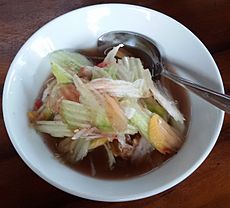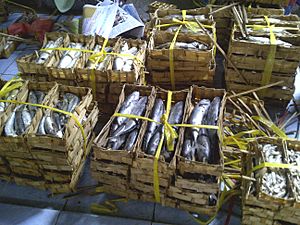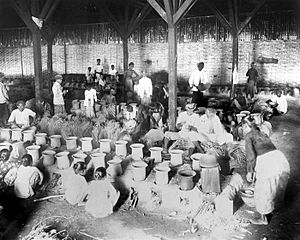Pindang facts for kids
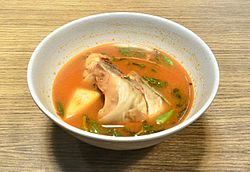
Pindang patin, pangasius fish in pindang soup
|
|
| Place of origin | Indonesia |
|---|---|
| Region or state | South Sumatra |
| Associated national cuisine | Indonesia, Malaysia and Singapore |
| Main ingredients | salt-boiled fish, i.e. fish cooked in salt and spices including tamarind juice, garlic, shallot, ginger, turmeric, lemongrass, galangal, chili pepper, Indonesian bayleaf, citrus leaf, shrimp paste, and palm sugar. |
Pindang is a special way of cooking from Indonesia and Malaysia. It means boiling food, usually fish or eggs, in salty or sour liquids. This cooking style started in Sumatra, especially in Palembang. But now, you can find it in other parts of Indonesia like Java and Kalimantan too.
Sometimes, "pindang" also refers to a tasty, sour, and spicy fish soup. This soup uses ingredients like tamarind to give it a unique flavor. One cool thing about pindang is that it helps keep food fresh for longer!
Contents
What Does 'Pindang' Mean?
The Indonesian dictionary says pindang is "salted and seasoned fish, then smoked or boiled until dry for preservation." So, in Indonesia, many boiled fish products are called pindang.
In Malaysia, it's known as pindang on the southwest coast. But on the northeast coast, they call it singgang. In Bali, pindang can also mean a seasoned fish brine. For example, rujak kuah pindang is a popular Bali fruit salad that uses this fish brine.
Pindang as a Delicious Dish
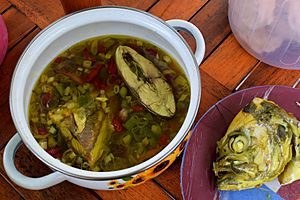
Even though you can find pindang dishes all over Indonesia, it's most famous in Palembang. Their special dish is pindang patin, which uses Pangasius fish. The South Sumatra province has many different kinds of pindang dishes.
People often use freshwater fish like ikan patin (Pangasius), catfish, carp, or gourami for pindang. But you can also make it with seafood like red snapper, milkfish, mackerel, tuna, grouper, or even shrimp.
To make the soup, cleaned fish is boiled in water with many spices. These include tamarind juice, garlic, shallot, ginger, turmeric, lemongrass, galangal, chili peppers, Indonesian bayleaf (daun salam), citrus leaf, shrimp paste, palm sugar, and salt. The soup often has pieces of chili, tomato, cucumber, lemon basil, and pineapple. This soupy dish tastes sour, a little sweet, and mildly spicy. Sometimes, Beef is also used to make Indonesian-style pindang.
Pindang as a Way to Preserve Food
The word pindang also describes a way to preserve food. It involves boiling ingredients in salt with special spices. These spices often contain something called tannin, which can come from soy sauce, shallot skin, guava leaves, or tea. This process gives the food a yellowish to brown color and helps it last longer than just plain boiled fish or eggs. So, pindang is a traditional Indonesian method to keep food fresh.
This method is mainly used for fish and eggs. In Indonesia, you can find many kinds of preserved pindang fish in traditional markets. Common fish used for pindang include tongkol (mackerel tuna), bandeng (milkfish), and kembung (mackerel).
Pindang is sometimes called "wet preservation." This is because after the food is covered in salt, it's boiled slowly until the liquid is gone and the salt is absorbed. Unlike salted fish, pindang uses less salt, so it's not as salty. Other ways Indonesians preserve food include salting (asin), drying with sugar (dendeng), pickling (acar), and smoking (asap).
Different Kinds of Pindang
There are many types of pindang, depending on the kind of fish or meat used, or the special spices from different regions. You can find pindang recipes in many cooking traditions across Southeast Asia, like Javanese, Betawi, Palembang, and Malay cuisine. In South Sumatra, there's a huge variety of pindang dishes.
Fish and Seafood Pindang
- Pindang bandeng or pindang serani: This is Milkfish pindang, a special dish from Betawi in Jakarta. It's also popular in Jepara, Central Java.
- Pindang baung: Made with ikan baung (a type of Hemibagrus fish), this is a specialty of Lampung province, Indonesia.
- Pindang cumi-cumi: This is Squid pindang, a special dish from the Bangka Belitung Islands.
- Pindang gabus: Made with snakehead fish, this is a specialty of South Sumatra.
- Pindang gurame kuning: This is gourami pindang in a yellowish sauce. It has a typical sour, hot, and spicy flavor.
- Pindang kakap: Indonesian-style red snapper pindang, cooked in a light yellowish soup with spices like turmeric, ginger, and chili peppers.
- Pindang kepala ikan manyung or pindang gombyang: This pindang uses the head of ikan manyung (a type of Ariidae fish). You can find it in Indramayu and Semarang.
- Pindang kerang: Made with mussels, this is another variant from Palembang.
- Pindang kerapu: Grouper pindang often served with pineapple.
- Pindang lampung: This is fish pindang from Lampung province. Common fish used are patin (pangasius) and gabus (snakehead).
- Pindang meranjat or pindang salai: This is a very hot and spicy pindang from Meranjat village in South Sumatra. It uses smoked fish like catfish or patin.
- Pindang musi rawas: A sour and fresh pindang from Musi Rawas, South Sumatra. It uses mashed tomato for its sour taste instead of tamarind.
- Pindang palembang or pindang patin: This is Pangasius pindang, the most famous specialty of Palembang.
- Pindang sekayu: A sweet-tasting fish pindang from Sekayu, using sweet soy sauce.
- Pindang telur gabus: This pindang uses fish roe (eggs) from gabus (snakehead fish). It's a specialty of South Sumatra.
- Pindang tongkol: A pindang that uses processed mackerel tuna. It's very common across Indonesia, especially in the Bangka Belitung Islands.
- Pindang udang: This pindang uses shrimp, pineapple, and lemon basil. It's another specialty of Palembang.
Eggs and Poultry Pindang
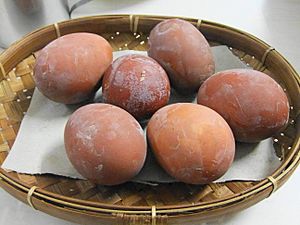
- Pindang telur: Eggs cooked using the pindang process. This is very popular in the Malay Archipelago, especially in Javanese cuisine.
- Pindang telur bebek or pindang telur itik: This is duck egg pindang. In Indonesia, it's a variation of the common pindang telur which usually uses chicken eggs.
- Pindang kaki ayam or pindang ceker: Chicken feet cooked in the pindang style. It uses belimbing wuluh fruit to make it sour.
Meat Pindang
- Nasi pindang semarang or pindang kudus: This dish features Beef brisket cooked in the pindang method with keluwek (a special nut). It's served over steamed rice and is a specialty of Semarang and Kudus in Central Java.
- Pindang iga or pindang tulang: This is Beef ribs pindang or bone pindang. Unlike most pindang dishes that use fish or eggs, this unique meat pindang is another specialty of Palembang, South Sumatra.
- Pindang kambing: This is goat meat pindang found in Indonesia.
Vegetable Pindang
- Pindang kacang panjang: This is Asparagus bean pindang. While it mainly has vegetables, it's usually served with pindang fish or small pieces of meat.
- Pindang pegagan: This pindang uses pegagan (a herb called Centella asiatica), turmeric, and chili pepper. The soup is light and not oily because the spices are boiled directly. It's a specialty of South Sumatra.
- Pindang rebung santan: Bamboo shoots pindang served in coconut milk.


